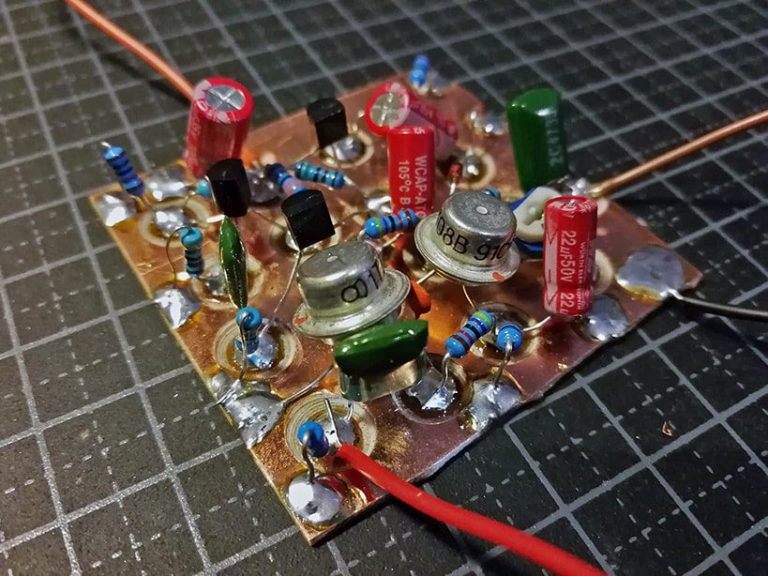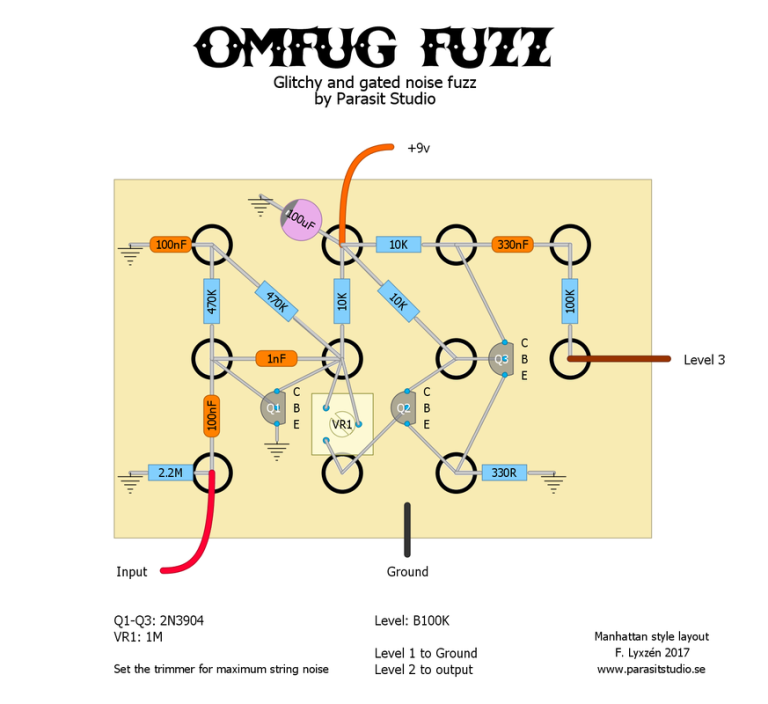Manhattan style pedal building
The "Manhattan style" is a very old method of circuit construction. It's especially popular among radio amateurs for high frequency circuits because it has a large solid ground plane that helps to reduce interference and noise.
It's also a fun way to build simple discrete circuits. :)
Pros:
- Fast build time (at least compared to etching boards)
- Easy building and schematic to layout conversion
- Great for quiet noise free-builds (superior to stripboard, perfboard and tagboard in this respect)
Cons:
- Doesn't suit IC chips
- Only good for smaller less complex circuits
Some people would probably not agree with the disadvantages I listed since I've seen people go crazy with complex build using IC chips ("dead bug" style) and even SMD components on Manhattan style builds.
Build process
To build Manhattan style you need a copperclad board. It only needs to be a one-sided copper layer. The first step is to make small cutouts in the copper for the component pads and cut the board to a good size (to fit the enclosure that you want to use). I use a bench drill with a circular drillbit to make small "islands" in the copper. Just be careful so you don't drill all the way through. It's a good idea to use a multimeter to check that all the pads are not conducting to the rest of the board (which will be connected to ground). Another common method that doesn't require a drill is to cut out small pieces of copperboard (from another piece of board) and glue them onto the main copperboard to serve as component mounting platforms.
The drill bits are called "diamond hole saw" drill bits. You can get a kit of them for cheap from Amazon/Temu ect.
I try to keep the distance between the middle of the pads to around 8mm-13mm so that the components are tight together, but not too close that is becomes too fiddely to work with. After the pads are made I like to pre-solder all the pads - just fill them up with a decent amount of solder. Now the board is perpared and it's time to start soldering in the components. Cut the legs of the component alittle shorter (check the distance against the board) and bend the legs alittle to make small "feet". Reflow the solder of the pad and put the component in. Hold it and let it cool for a few seconds, then do the other side. As you go along there will often be several components connected to the same pad, and then it helps to apply some new solder to the pad when adding more components. I find that it's best to start in the upper left corner and work your way through the board from left to right.
Schematic to layout
Before preparing the board, it's a good idea to make a sketch of the board layout. Converting a schematic to a Manhattan style layout is generally very easy since the layout will closely reflect the schematic in most cases. Here's to the right is an example of a circuit, the LPB1 booster - a very simple transistor amplifier.
The first thing you need to do is to identify and count all the common nodes (or "nets" as they are typically called in PCB software). This is how many pads we need to drill on the board. Don't count the ground connection, as it will be connected to the rest of the copperboard as the groundplane.
As you can see in this example, the layout follows the schematic with a few minor changes (just to have the pads lined up nicely). I normally just use pen and paper to make the layouts.
Parasit Studio originals
I designed two circuits specially for this article, that both suit the Manhattan style. :)
OMFUG Fuzz
The Omfug is a gated and glitchy square wave one-knob fuzz. It's basically the preamp section of the Darkadiator (a discrete guitar synth) - a single gainstage followed by a schmitt trigger. I thought that the Omfug was a fitting name. A homage to the classic punk club CBGB's that was located in Manhattan... :)
In the sound example I used very hot humbuckers. That's why it sounds so compressed.
The Darby Fuzz
Another one-knob fuzz. This is more of a ordinary fuzz loosely based on a fuzzface topology. It cleans up really well when turning your guitar volume down. I wanted to find a use for all those russian transistors that I have laying around so the signal path uses two germanium transistors. The rest of the circuit is a discrete voltage inverter, designed specifically for the manhattan style in mind so I could keep everything on the same board. You can play around with the values for the input and output capacitors for different bass response and thickness. The name is a homage to the band The Germs (because it's a germ-anium fuzz hehe...).
The discrete voltage inverter is not something I would recommend using for any other build style that can accomodate IC chips since an IC based voltage inverter will be far superiour in every way. This one can only supply a few mV before the voltage starts to drop.
Conclusion
Even through it might seem like a step backward, it's been really fun to make something different for a change. Expanding my bag of tricks, learning and challenging myself to come up with new stuff is what keeps this hobby fun and interesting for me. I haven't seen many pedalbuilder using this technique and I was inspiried to try it from a great HAM radio guy that I follow on youtube.
Check out his channel: https://www.youtube.com/user/w2aew/





